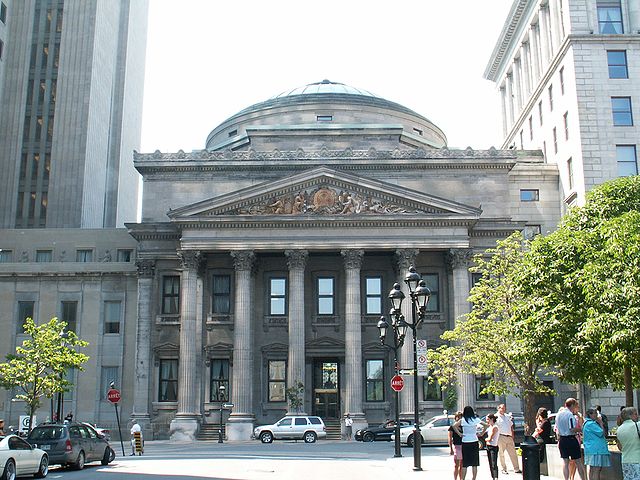Top Qs
Timeline
Chat
Perspective
List of banks and credit unions in Canada
From Wikipedia, the free encyclopedia
Remove ads
This is a list of banks in Canada, including chartered banks, credit unions, trusts, and other financial services companies that offer banking services and may be popularly referred to as "banks".


Largest banks
Summarize
Perspective
Big Five
The top five Canadian banks are collectively referred to as the "Big Five" due to their dominant position and significant influence within the country's banking and financial industry. This term has been used for many years to characterize these major banks, and it highlights their substantial market share and impact on Canada's economy. The financial sector of Canada is especially concentrated in these banks, which has been seen as a result of protectionist policies of the government and the country's small and dispersed population. These banks grew at an extraordinary rate of 10.7 percent per year, on average, from 2008 to 2018 compared with 3.64 percent for the five largest U.S. banks.[1] While most Canadian banks operate only within Canada, the Big Five are best described as Canadian multinational financial conglomerates that each have a large Canadian banking division.[2]
Big Six
National Bank of Canada, which began as a regional bank in Quebec but expanded nationally, is the sixth largest Canadian bank.[9] In 2025 it took over the Canadian Western Bank. In 2022, Canada’s Big Six held about 93% of all banking assets in the country. It is the same share they held a decade earlier, and a decade before that.[10] RBC’s $13.5-billion takeover of HSBC’s Canadian division, announced in November 2022, will see it receive around $134 billion in HSBC assets[11] and would increase the 93% share of assets the Big Six have to almost 95%.[10]
Other large banks (excluding Big Six)
Remove ads
Importance of Canada's financial institutions
Summarize
Perspective
Domestic systemically important bank (D-SIB)
A domestic systemically important bank (D-SIB) is a bank that could disrupt the domestic economy should it fail. Canada's Big Six are designated as D-SIBs. D-SIBs are so important to the functioning of the financial system and the economy that they cannot be wound up under a conventional bankruptcy and liquidation process should they fail. The failure of any one of Canada’s D-SIBs, with the potential loss of financial services, even for a short period of time, could have a serious impact on Canada’s economy.[17]
Desjardins
The Autorité des marchés financiers, which oversees Quebec’s financial sector, designated Desjardins Group as a D-SIB.[18]
Global systemically important bank (G-SIB)
A global systemically important bank is a bank whose systemic risk profile is deemed to be of such importance that the bank’s failure would trigger a wider financial crisis and threaten the global economy. The Basel Committee has developed a formula for determining which banks are G-SIBs, deploying criteria including size, interconnectedness and complexity. National regulators subject banks determined to be G-SIBs to stricter prudential regulation such as higher capital requirements and extra surcharges, or more stringent stress tests.[19]
In Canada, the Office of the Superintendent of Financial Institutions designated Royal Bank of Canada and Toronto-Dominion Bank as G-SIBs as well as D-SIBs.[20][17]
Remove ads
Banks by legal classification
Summarize
Perspective
Banks in Canada are classified by their ownership as domestic banks, subsidiaries of foreign banks, or branches of foreign banks. For a greater explanation of the classifications, see Banking in Canada and Bank Act (Canada).
Schedule I banks (domestic banks)
Under the Bank Act, Schedule I are banks that are not a subsidiary of a foreign bank, even if they have foreign shareholders. There are 35 domestic banks, including 3 federally regulated Credit Unions as of 8 March 2024.[21]

Schedule II banks (subsidiaries of foreign banks)

Schedule II banks are banks allowed to accept deposits and which are subsidiaries of a foreign bank. As of March 2024, there were 15 of these banks in Canada.[21]
Schedule III banks (branches of foreign banks)
Full service
The following banks are not authorized to accept deposits in Canada of less than $150,000. As of August 2016, there were 28 such banks in Canada.[21]
Lending only
The following banks are prohibited from accepting deposits or borrowing money except from financial institutions. There were four such banks in Canada as of May 2025.[21]
- Crédit Agricole Corporate and Investment Bank (Canada Branch)
- Natixis Canada Branch
Remove ads
Government-owned financial institutions

- Bank of Canada (Central Bank)
- Business Development Bank of Canada
- Farm Credit Canada – Government-owned Farm Credit is not a deposit-taking bank. It is, however, a major lender to the agriculture and agri-food industries.
- ATB Financial (Government of Alberta Crown Corporation)
Credit unions
Summarize
Perspective


Canada has a strong co-operative financial services sector, which consists of credit unions (caisses populaires in Quebec and other French speaking regions). At the end of 2001, Canada's credit union sector consisted of 681 credit unions and 914 caisses populaires, with more than 3,600 locations and 4,100 automated teller machines.[45] By the end of 2019, consolidation reduced this number to 251 credits unions and caisses populaires outside Quebec, according to the Canadian Credit Union Association (CCUA).[46][47][48] Canada has the world's highest per capita membership in the credit union movement, with over 10 million members, or about one-third of the Canadian population. While the sector is active in all parts of the country, it is strongest in the western provinces and in Quebec. In Quebec 70 per cent of the population belongs to a caisse populaire, while in Saskatchewan close to 60 per cent belongs to a credit union.
Credit unions outside Quebec
As of 31 December 2022, the 208 credit unions and caisses populaires outside Quebec reported combined assets of $308.9 billion:[49]
Desjardins
Most credit unions in Quebec (and some outside the province) are part of a network which operates as the Desjardins Group. Desjardins Group owns and operates a range of subsidiaries, including a securities brokerage, a venture capital firm, and a bank based in Florida.[50]
As of 25 December 2023, Desjardins Group's consolidated assets totalled $407 billion CAD.[51]
Remove ads
Defunct and merged banks
Remove ads
Credit agencies
See also
References
External links
Wikiwand - on
Seamless Wikipedia browsing. On steroids.
Remove ads



